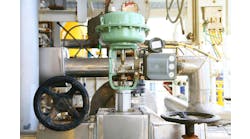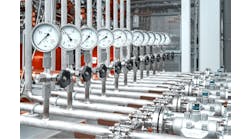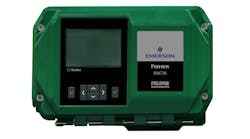Dedham, Mass.,July 8 -- The worldwide control valve market enjoyed yet another year of historic double-digit growth between 2006 and 2007. Strong revenue growth is expected to continue at a compounded annual growth rate (CAGR) of 6% over the next five years. The market reached $4.8 billion in 2007 and is forecasted to exceed $6.4 billion in 2012, according to a new ARC Advisory Group study.Does 2007 represent the peak year for growth in the market? It was too early to tell halfway through the year, but indications show that growth could once again approach historic levels in 2008, with many of the leading control valve suppliers experiencing strong backlog with no slowdown in sight. Control valve suppliers continued to post strong revenue growth in the first quarter of 2008. Though the North American and European markets have slowed somewhat, suppliers are relatively immune, thanks to increased demand in developing markets, such as China, India and the Middle East, which provided strong project activity, particularly in the oil & gas sector, according to Senior Analyst David Clayton, the principal author of ARCs Control Valve Worldwide Outlook (www.arcweb.com/res/cvap).Despite strong growth opportunities, challenges remain
In many ways, control valve suppliers are faced with the same opportunities and challenges as they were at this time last year. While the extremely robust growth occurring in developing markets provides control valve suppliers a tremendous opportunity to grow their business, establishing a global supply and logistics system and designing new products for the changing needs of the global control valve market are key challenges control valve suppliers must overcome.The ability to guarantee delivery times is more difficult now than ever before as demand for control valves continues to increase from developing markets around the globe and many control valve suppliers face manufacturing constraints. To ensure strong global delivery and service capabilities, control valve suppliers are finding it necessary to invest heavily in manufacturing and project engineering capabilities throughout the globe, with a particular focus in developing markets. On the supply-side of the equation, long-term agreements with foundries in North America, Europe and Asia remain critical to protect needed capacity and lead times. Those suppliers who did not establish long-term agreements with foundries during the lean years were not prepared for the strong surge in demand and are finding it difficult to secure the valve castings necessary to meet demand.Taking full advantage of the robust project activity in developing markets requires significant product investment as well. Many control valve suppliers have been forced to expand their control valve line sizes and high-pressure class ratings to compete in these markets. Many of the new projects in the Middle East require extremely large valves capable of withstanding extreme temperatures while providing tight shutoff capabilities. High-pressure applications in deep offshore oil wells that often exceed 30,000 feet require high thrusts/torque capabilities from control valves as well.Competing in developed countries requires product investment as well
Remaining competitive in developed markets requires a different set of product investments. Many of the brownfield projects in the developed regions are now implementing FDT-based PAM solutions to provide access to data embedded in a diverse set of smart field devices and other production equipment from multiple vendors running on various communication protocols throughout the company. To take advantage of this opportunity, control valve suppliers have been active in developing device type managers(DTMs) that enable their digital positioners to work with FDT-based PAM solutions. Many control valve suppliers are also designing their digital positioners to support EDDL for HART, Foundation fieldbus and Profibus as well.Another important product investment control valve suppliers are considering is the development of WirelessHART products, now that the HART Version 7 specification with WirelessHART has been approved. WirelessHART entails much more than simply adding a radio to HART field devices. The development of WirelessHART positioners enhances the functionality of HART devices and preserves the viability of HART valve positioners indefinitely. ARC estimates only 10% to 15% of the nearly 25 million installed HART devices are connected to PAM systems. WirelessHART may be the enabler needed to connect these installed devices to PAM systems.Hydrocarbon investments in the Middle East continue to drive market growthControl valve suppliers continued to report big project wins in the oil & gas, refining and petrochemical industries in the first quarter of 2008. Though the North American and European markets have slowed somewhat, suppliers are relatively immune, thanks to increased demand in developing markets, such as China, India and the Middle East.Worldwide growth of energy production continued unabated through 2007. Global oil & gas companies continue to reap unprecedented windfall profits thanks to historically high oil prices, even as exploration costs increase and international politics play a greater role. The record profits being enjoyed by oil & gas companies, one of the largest consumers of control valves, gives them ample capital to increase production and refining capacity to satisfy demand, which shows no sign of abating. The value of oil has also caused oil & gas companies to work to improve their monitoring processes to prevent product loss and optimize production, which will require increased adoption of intelligent field devices, including control valves.
In many ways, control valve suppliers are faced with the same opportunities and challenges as they were at this time last year. While the extremely robust growth occurring in developing markets provides control valve suppliers a tremendous opportunity to grow their business, establishing a global supply and logistics system and designing new products for the changing needs of the global control valve market are key challenges control valve suppliers must overcome.The ability to guarantee delivery times is more difficult now than ever before as demand for control valves continues to increase from developing markets around the globe and many control valve suppliers face manufacturing constraints. To ensure strong global delivery and service capabilities, control valve suppliers are finding it necessary to invest heavily in manufacturing and project engineering capabilities throughout the globe, with a particular focus in developing markets. On the supply-side of the equation, long-term agreements with foundries in North America, Europe and Asia remain critical to protect needed capacity and lead times. Those suppliers who did not establish long-term agreements with foundries during the lean years were not prepared for the strong surge in demand and are finding it difficult to secure the valve castings necessary to meet demand.Taking full advantage of the robust project activity in developing markets requires significant product investment as well. Many control valve suppliers have been forced to expand their control valve line sizes and high-pressure class ratings to compete in these markets. Many of the new projects in the Middle East require extremely large valves capable of withstanding extreme temperatures while providing tight shutoff capabilities. High-pressure applications in deep offshore oil wells that often exceed 30,000 feet require high thrusts/torque capabilities from control valves as well.Competing in developed countries requires product investment as well
Remaining competitive in developed markets requires a different set of product investments. Many of the brownfield projects in the developed regions are now implementing FDT-based PAM solutions to provide access to data embedded in a diverse set of smart field devices and other production equipment from multiple vendors running on various communication protocols throughout the company. To take advantage of this opportunity, control valve suppliers have been active in developing device type managers(DTMs) that enable their digital positioners to work with FDT-based PAM solutions. Many control valve suppliers are also designing their digital positioners to support EDDL for HART, Foundation fieldbus and Profibus as well.Another important product investment control valve suppliers are considering is the development of WirelessHART products, now that the HART Version 7 specification with WirelessHART has been approved. WirelessHART entails much more than simply adding a radio to HART field devices. The development of WirelessHART positioners enhances the functionality of HART devices and preserves the viability of HART valve positioners indefinitely. ARC estimates only 10% to 15% of the nearly 25 million installed HART devices are connected to PAM systems. WirelessHART may be the enabler needed to connect these installed devices to PAM systems.Hydrocarbon investments in the Middle East continue to drive market growthControl valve suppliers continued to report big project wins in the oil & gas, refining and petrochemical industries in the first quarter of 2008. Though the North American and European markets have slowed somewhat, suppliers are relatively immune, thanks to increased demand in developing markets, such as China, India and the Middle East.Worldwide growth of energy production continued unabated through 2007. Global oil & gas companies continue to reap unprecedented windfall profits thanks to historically high oil prices, even as exploration costs increase and international politics play a greater role. The record profits being enjoyed by oil & gas companies, one of the largest consumers of control valves, gives them ample capital to increase production and refining capacity to satisfy demand, which shows no sign of abating. The value of oil has also caused oil & gas companies to work to improve their monitoring processes to prevent product loss and optimize production, which will require increased adoption of intelligent field devices, including control valves.


